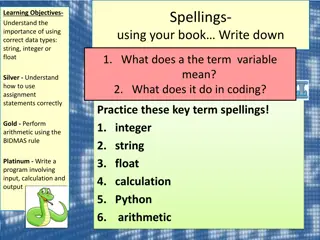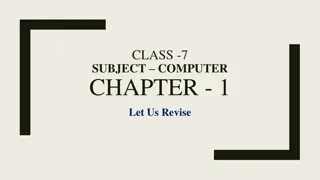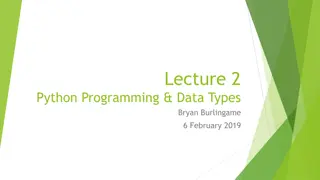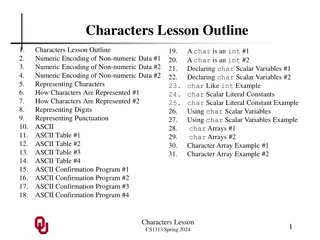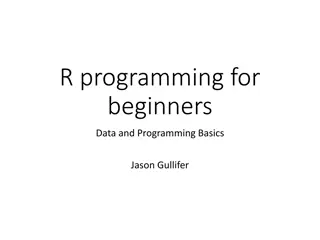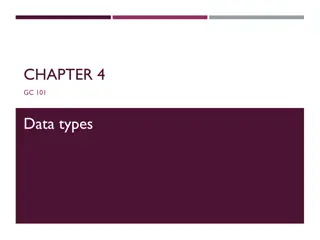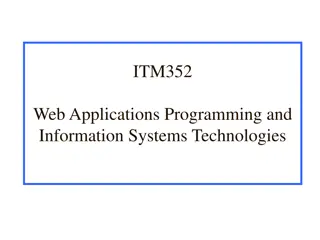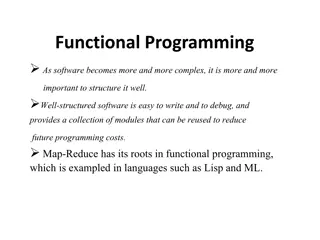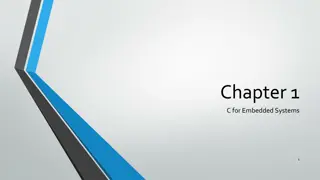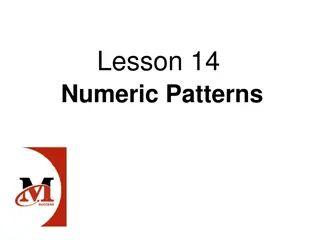Understanding Numeric Data Types in Programming
Exploring the world of numeric data types, this content delves into the concepts of integers and real numbers in mathematics as well as their representation in computing. It covers the use of literal constants, named constants, and the differences between integers and real numbers. The content also touches on the basics of declaring int and float variables, the size and declaration of float variables, and the approximation of floating-point numbers. With a focus on practical examples and explanations, this overview provides insights into the fundamental aspects of working with numeric data types in programming.
Download Presentation

Please find below an Image/Link to download the presentation.
The content on the website is provided AS IS for your information and personal use only. It may not be sold, licensed, or shared on other websites without obtaining consent from the author. Download presentation by click this link. If you encounter any issues during the download, it is possible that the publisher has removed the file from their server.
E N D
Presentation Transcript
Numeric Data Types Outline 1. 2. 3. 4. 5. 6. 7. 8. 9. 10. The Same Source Code without Comments 11. int Literal Constants 12. int Literal Constants Usage 13. int Literal Constants Usage: Good & Bad 14. int Named Constants Example #1 15. int Named Constants Example #2 16. Real Numbers in Mathematics 17. Reals: Digits to the Right of the Decimal 18. A Fun Rational Number 19. Integers vs Reals in Mathematics 20. Representing Real Numbers in a Computer 21. float Literal Constants Numeric Data Types Outline Data Types Integers in Mathematics Integers in Computing Integers A.K.A. Fixed Point Numbers Declaring int Variables intData Don t Have to Be 4 Bytes Long int Declaration Example Program Part 1 int Declaration Example Program Part 2 22. 23. 24. 25. 26. 27. 28. 29. 30. 31. 32. 33. 34. 35. 36. 37. 38. 39. 40. 41. 42. Declaring float Variables float Variable Size float Declaration Example Part 1 float Declaration Example Part 2 The Same Source Code without Comments Scientific Notation Floating Point Numbers float Approximation #1 float Approximation #2 float Approximation #3 float Approximation Example Program Floating Point Approximation Examples float Literal Constants float Literal Constant Examples float Literal Constants Usage float Lit Constant Usage: Good & Bad float Named Constants Example Program #1 float Named Constants Example Program #2 Why Have Both Reals & Integers? #1 Why Have Both Reals & Integers? #2 Programming Exercise Numeric Data Types Lesson CS1313 Fall 2024 1
Data Types A data type is (surprise!) a type of data: Numeric int: integer float: floating point (also known as real) Non-numeric char: character Note that this list of data types ISN T exhaustive there are many more data types (and you can define your own). #include <stdio.h> int main () { /* main */ float standard_deviation, relative_humidity; int count, number_of_silly_people; char middle_initial, hometown[30]; } /* main */ Numeric Data Types Lesson CS1313 Fall 2024 2
Integers in Mathematics Mathematically, an integeris: any number (positive, negative or zero) that has nothing but zeros to the right of its decimal point: -3984.00000000... 0.00000000... 23085.00000000... Another way to think of integers is as the counting numbers, and 1, 2, 3, 4, 5, 6, ... their negatives (additive inverses), and -1, -2, -3, -4, -5, -6, zero. In mathematics, the range on integers is infinite in both directions: - to + Numeric Data Types Lesson CS1313 Fall 2024 3
Integers in Computing An integer in computing has mostly the same mathematical properties as an integer in mathematics. An integer in computing has a finite range (minimum, maximum). An integer in computing also has a particular way of being represented in memory (which we ll see later in the course, time permitting) and a particular way of being operated on. In C (and in most programming languages), int literal constants are expressed without a decimal point: -3984 0 23085 Numeric Data Types Lesson CS1313 Fall 2024 4
Integers A.K.A. Fixed Point Numbers Integers are also known as fixed pointnumbers, because they have an invisible decimal point in a fixed (unchanging) position. Specifically, every integer s invisible decimal point is to the right of the rightmost digit (the ones digit): -3984 invisible decimal point in a fixed (unchanging) place 0 23085 Numeric Data Types Lesson CS1313 Fall 2024 5
Declaring int Variables int x; This declaration tells the compiler to grab a group of bytes, name them x, and think of them as storing an int. How many bytes? That depends on the platform and the compiler, but these days the typical answer is that an int takes 4 bytes (32 bits) in most cases: x: For example, on x86-based Linux PCs such as ssh.ou.edu, using the gcc compiler from gnu.org (the compiler that we re using in this course), the size of an int is 4 bytes. Numeric Data Types Lesson CS1313 Fall 2024 6
intData Dont Have to Be 4 Bytes Long On some platforms(combination of hardware family and operating system), on some compilers, allintsare 4 bytes. On other platforms, the defaultint size is 4 bytes, but the size of an int can be changed by using a compiler option. Notice that different compilers for the same language can have different names, different defaults and different options. While there are many common features, compiler vendors are under no compulsion to follow them. Numeric Data Types Lesson CS1313 Fall 2024 7
int Declaration Example Program Part 1 % cat assign.c /* ********************************************* *** Program: assign *** *** Author: Henry Neeman (hneeman@ou.edu) *** *** Course: CS 1313 010 Fall 2024 *** *** Lab: Sec 014 Fridays 1:00pm *** *** Description: Declares, assigns and *** *** outputs a variable. *** ********************************************* */ #include <stdio.h> int main () { /* main */ /* * ****************************************** * Declaration section * ****************************************** * ******************* * Local variables * ******************* * * height_in_cm: my height in cm */ int height_in_cm; Numeric Data Types Lesson CS1313 Fall 2024 8
int Declaration Example Program Part 2 /* ********************************************* * Execution section * ********************************************* * Assign the integer value 160 to height_in_cm. */ height_in_cm = 160; /* * Print height_in_cm to standard output. */ printf("My height is %d cm.\n", height_in_cm); } /* main */ % gcc -o assign assign.c % assign My height is 160 cm. Numeric Data Types Lesson CS1313 Fall 2024 9
The Same Source Code without Comments % cat assign.c #include <stdio.h> int main () { /* main */ int height_in_cm; height_in_cm = 160; printf("My height is %d cm.\n", height_in_cm); } /* main */ % gcc -o assign assign.c % assign My height is 160 cm. Numeric Data Types Lesson CS1313 Fall 2024 10
int Literal Constants Anint literal constantis any sequence of digits, possibly preceded by an optional sign: CORRECT: 0 -345 768 +12345 INCORRECT: 1,234,567 INCORRECT: No commas allowed. 12.0 INCORRECT: No decimal point allowed. --4 ++3 INCORRECT: A maximum of one sign per int literal constant. 5- 7+ INCORRECT: The sign must come before the digit(s), not after. Numeric Data Types Lesson CS1313 Fall 2024 11
int Literal Constants Usage We can use int literal constants in several ways: In declaring and initializing a named constant: const int w = 0; /* 0 is an int literal constant */ In initializing a variable (within a declaration): int x = -19; /* -19 is an int literal constant */ In an assignment: y = +7; /* +7 is an int literal constant */ In an expression (which we ll learn more about): z = y + 9; /* 9 is an int literal constant */ Numeric Data Types Lesson CS1313 Fall 2024 12
int Literal Constants Usage: Good & Bad We can use int literal constants in several ways: In declaring and initializing a named constant: const int w = 0; /* This is GOOD. */ In initializing a variable (within a declaration): int x = -19; /* This is GOOD. */ In an assignment: y = +7; /* This is BAD BAD BAD! */ In an expression (which we ll learn more about): z = y + 9; /* This is BAD BAD BAD! */ Numeric Data Types Lesson CS1313 Fall 2024 13
int Named Constants Example #1 #include <stdio.h> int main () { /* main */ const int number_of_people_to_tango = 2; const int inches_per_foot = 12; const int degrees_in_a_circle = 360; printf("It takes %d to tango.\n", number_of_people_to_tango); printf("\n"); printf("There are %d inches in a foot.\n", inches_per_foot); printf("\n"); printf("There are %d degrees in a circle.\n", degrees_in_a_circle); } /* main */ Numeric Data Types Lesson CS1313 Fall 2024 14
int Named Constants Example #2 % gcc -o intconsts intconsts.c % intconsts It takes 2 to tango. There are 12 inches in a foot. There are 360 degrees in a circle. ASIDE: Notice that you can output a blank line by outputting a string literal containing only the newline character \n. Numeric Data Types Lesson CS1313 Fall 2024 15
Real Numbers in Mathematics Mathematically, a real numberis a number (positive, negative or zero) with any sequence of digits on either side of the decimal point: -3984.75 0.1111111... 3.1415926... In mathematics, the range on real numbers is infinite in both directions: - to + Numeric Data Types Lesson CS1313 Fall 2024 16
Reals: Digits to the Right of the Decimal In mathematics, the string of digits to the right of the decimal point can be either: terminating (a finite number of nonzero digits, maybe even NO nonzero digits), OR repeating (a finite sequence of digits repeated infinitely), OR non-repeating. In mathematics, there are infinitely many real numbers. In fact, there are infinitely many real numbers between any two real numbers. For example, there are infinitely many real numbers between 0 and 0.00000000000000001. Numeric Data Types Lesson CS1313 Fall 2024 17
A Fun Rational Number 1 / 998,001 has, as its repeating decimal expansion, every 3-digit integer from 000 to 999, in order, EXCEPT 998: https://img-9gag-fun.9cache.com/photo/aK69rpN_700bwp.jpg Numeric Data Types Lesson CS1313 Fall 2024 18
Integers vs Reals in Mathematics Notice that, in mathematics, all integers are real numbers, but not all real numbers are integers. In particular, mathematically, every integer is a real number, because it has a finite number of nonzero digits to the right of the decimal point. Specifically, an integer has NO nonzero digits to the right of the decimal point. Numeric Data Types Lesson CS1313 Fall 2024 19
Representing Real Numbers in a Computer In a computer, a real value is stored in a finite number of bits (typically 32 or 64 bits). But there are infinitely many real numbers, and in fact there are infinitely many real numbers between any two real numbers. So a computer s representation of real numbers can only approximatemost mathematical real numbers. This is because only finitely many different values can be stored in a finite number of bits. For example, 32 bits can have only 232 possible different values. A real value in computing has a finite range (minimum, maximum). Like integers, real numbers have particular ways of being represented in memory and of being operated on. Numeric Data Types Lesson CS1313 Fall 2024 20
float Literal Constants In C (and in most programming languages), float literal constants often are expressed with a decimal point: -3984.75 0.0 23085.1235 Recall that, in mathematics, all integers are reals, but not all reals are integers. Similarly, in most programming languages, some real numbers are mathematical integers (for example, 0.0), even though they are represented in memory as reals. In computing, reals are often called floating pointnumbers. We ll see why soon. Numeric Data Types Lesson CS1313 Fall 2024 21
Declaring float Variables float x; This declaration tells the compiler to grab a group of bytes, name them x, and think of them as storing a float, which is to say a real number. How many bytes? That depends on the platform and the compiler, but these days the typical answer is that real numbers in most cases take 4 bytes (32 bits) or 8 bytes (64 bits): x: x: Numeric Data Types Lesson CS1313 Fall 2024 22
float Variable Size For example, on x86-based Linux PCs such as ssh.ou.edu, using the gcc compiler from gnu.org, which we re using in this course, the default size of a float is 4 bytes (32 bits). Numeric Data Types Lesson CS1313 Fall 2024 23
float Declaration Example Part 1 % cat realassign.c /* ********************************************* *** Program: realassign *** *** Author: Henry Neeman (hneeman@ou.edu) *** *** Course: CS 1313 010 Fall 2024 *** *** Lab: Sec 014 Fridays 1:00pm *** *** Description: Declares, assigns and *** *** outputs a real variable. *** ********************************************* */ #include <stdio.h> int main () { /* main */ /* * ****************************************** * Declaration section * ****************************************** * ******************* * Local variables * ******************* * * height_in_m: my height in m */ float height_in_m; Numeric Data Types Lesson CS1313 Fall 2024 24
float Declaration Example Part 2 /* ********************************************* * Execution section * ********************************************* * Assign the real value 1.6 to height_in_m. */ height_in_m = 1.6; /* * Print height_in_m to standard output. */ printf("My height is %f m.\n", height_in_m); } /* main */ % gcc -o realassign realassign.c % realassign My height is 1.600000 m. Numeric Data Types Lesson CS1313 Fall 2024 25
The Same Source Code without Comments % cat realassign.c #include <stdio.h> int main () { /* main */ float height_in_m; height_in_m = 1.6; printf("My height is %f m.\n", height_in_m); } /* main */ % gcc -o realassign realassign.c % realassign My height is 1.600000 m. Numeric Data Types Lesson CS1313 Fall 2024 26
Scientific Notation In technical situations, we often encounter scientific notation, which is a way of writing numbers that are either very very big or very very small: 6,300,000,000,000,000 = 6.3 1015 0.0000000000271 = 2.71 10 11 In C, we can express such numbers in a similar way: 6,300,000,000,000,000 = 6.3e+15 0.0000000000271 = 2.71e-11 Here, the e, which is short for exponent, indicates that the sequence of characters to the right of the e an optional sign followed by one or more digits is the power of 10 that the number to the left of the e should be multiplied by. Numeric Data Types Lesson CS1313 Fall 2024 27
Floating Point Numbers When we express a real number in scientific notation, the decimal point is immediately to the right of the leftmost non-zero digit. So, the decimal point doesn t have to be to the right of the ones digit; instead, it can be after any digit. It doesn t have a fixed location, so we say that it floats. So, we sometimes call real numbers floating pointnumbers. We recall that, similarly, integers are sometimes called fixed pointnumbers, because they have an implicit decimal point that is in a fixed location, always to the right of the ones digit (that is, the rightmost digit), with implied zeros to the right of the implied decimal point: 6, 300, 000, 000, 000, 000 = 6, 300, 000, 000, 000, 000.0000 . . . Numeric Data Types Lesson CS1313 Fall 2024 28
float Approximation #1 In C (and in most other programming languages), real numbers are represented by a finite number of bits. For example, on Linux PCs like ssh.ou.edu, the default size of a float is 32 bits (4 bytes). We know that 32 bits can store 232 = 22 230 = 22 210 210 210 ~ 4 103 103 103 = roughly 4,000,000,000 possible values. That s a lot of possibilities. But: There are infinitely many (mathematically) real numbers, and in fact infinitely many real numbers between any two real numbers. Numeric Data Types Lesson CS1313 Fall 2024 29
float Approximation #2 For example, between 1 and 10 we have: 2 2.9 2.09 2.009 2.0009 3.0008 4.0007 5.0006 6.0005 7.0004 8.0003 9.0002 3 3.8 3.08 3.008 4 4.7 4.07 4.007 5 5.6 5.06 5.006 6 6.5 6.05 6.005 7 7.4 7.04 7.004 8 8.3 8.03 8.003 9 9.2 9.02 9.002 So, no matter how many bits we use to represent a real number, we won t be able to exactly represent most real numbers, because we have an infinite set of real numbers to be represented in a finite number of bits. Numeric Data Types Lesson CS1313 Fall 2024 30
float Approximation #3 No matter how many bits we use to represent a real number, we won t be able to exactly represent most real numbers, because we have an infinite set of real numbers to be represented in a finite number of bits. For example: if we can exactly represent 0.125 but not 0.125000000000000000000000000000001, then we have to use 0.125 to approximate 0.125000000000000000000000000000001. Numeric Data Types Lesson CS1313 Fall 2024 31
float Approximation Example Program % cat real_approx.c #include <stdio.h> int main () { /* main */ float input_value; printf("What real value would you like stored?\n"); scanf("%f", &input_value); printf("That real value is stored as %f.\n", input_value); } /* main */ % gcc -o real_approx real_approx.c % real_approx What real value would you like stored? 0.125000000000000000000000000000001 That real value is stored as 0.125000. Numeric Data Types Lesson CS1313 Fall 2024 32
Floating Point Approximation Examples 1.25 = 20 + 2-2 0.1 ~ 2-4+ 2-5+ 2-8+ 2-9+ 2-12+ 2-13+ 2-16+ 2-17+ 2-20+ 2-21+ 2-24+ 2-25+ 2-28+ 2-29+ 2-32+ 2-33+ 2-36+ 2-37+ 2-40+ 2-41+ 2-44 + 2-45+ 2-48+ 2-49+ 2-52+ 2-53+ 2-55 http://bartaz.github.io/ieee754-visualization/ Numeric Data Types Lesson CS1313 Fall 2024 33
float Literal Constants Afloat literal constantis: an optional sign, followed by a sequence of one or more digits (which is optional if there are digits to the right of the decimal point), followed by a decimal point (which is optional if there is an exponent), followed by an optional sequence of one or more digits to the right of the decimal point (if there is one), followed by an optional exponent string, which consists of an e, an optional sign, and a sequence of one or more digits. You can tell that a numeric literal constant is a float literal constant because it has either a decimal point, or ane, or both. Numeric Data Types Lesson CS1313 Fall 2024 34
float Literal Constant Examples 0.0 -345.3847 7.68e+05 +12345.434e-13 125.e1 1e1 Numeric Data Types Lesson CS1313 Fall 2024 35
float Literal Constants Usage We can use float literal constants in several ways: In declaring and initializing a named constant: const float w = 0.0; /* 0.0 is a float literal constant */ In initializing a variable (within a declaration): float x = -1e-05; /* -1e-05 is a float literal constant */ In an assignment: y = +7.24690120; /* +7.24690120 is a float literal * constant */ In an expression (which we ll learn more about): z = y + 125e3; /* 125e3 is a float literal constant */ Numeric Data Types Lesson CS1313 Fall 2024 36
float Lit Constant Usage: Good & Bad We can use float literal constants in several ways: In declaring and initializing a named constant: const float w = 0.0; /* This is GOOD. */ In initializing a variable (within a declaration): float x = -1e-05; /* This is GOOD. */ In an assignment: y = +7.24690120; /* This is BAD BAD BAD! */ In an expression (which we ll learn more about): z = y + 125e3; /* This is BAD BAD BAD! */ Numeric Data Types Lesson CS1313 Fall 2024 37
float Named Constants Example Program #1 #include <stdio.h> int main () { /* main */ const float pi = 3.1415926; const float radians_in_a_semicircle = pi; const float number_of_days_in_a_solar_year = 365.242190; const float US_inflation_percent_in_1998 = 1.6; printf("pi = %f\n", pi); printf("\n"); printf("There are %f radians in a semicircle.\n", radians_in_a_semicircle); printf("\n"); printf("There are %f days in a solar year.\n", number_of_days_in_a_solar_year); printf("\n"); printf("The US inflation rate in 1998 was %f%%.\n", US_inflation_percent_in_1998); } /* main */ Numeric Data Types Lesson CS1313 Fall 2024 38
float Named Constants Example Program #2 % gcc -o real_constants real_constants.c % real_constants pi = 3.141593 There are 3.141593 radians in a semicircle. There are 365.242188 days in a solar year. The US inflation rate in 1998 was 1.600000%. Again, notice that you can output a blank line by printing a string literal containing only the newline character \n. Reference: http://scienceworld.wolfram.com/astronomy/LeapYear.html Numeric Data Types Lesson CS1313 Fall 2024 39
Why Have Both Reals & Integers? #1 1. 2. Precision: intsare exact, floatsare approximate. Appropriateness: For some tasks, intsfit the properties of the data better. For example: a. counting the number of students in a class; b. array indexing (which we ll see later). Readability: When we declare a variable to be an int, we make it obvious to anyone reading our program that the variable will contain only certain values (specifically, only integer values). 3. Numeric Data Types Lesson CS1313 Fall 2024 40
Why Have Both Reals & Integers? #2 4. Enforcement: When we declare a variable to be an int, no one can put a non-int into it. History: For a long time, operations on int data were much quicker than operations on float data, so anything that you could do with ints, you would. Nowadays, operations on floats can be as fast as (or faster than!) operations on ints, so speed is no longer an issue. 5. Numeric Data Types Lesson CS1313 Fall 2024 41
Programming Exercise Write a program that inputs, and then outputs, the user s number of first cousins and height in meters. The program should do the following: 1. greet the user; 2. prompt the user to input their number of cousins; 3. input their number of cousins; 4. prompt the user to input their height in meters; 5. input their height in meters; 6. output their number of cousins, in a full sentence; 7. output their height in meters, in a full sentence. Be sure to use appropriate data types and placeholders. Numeric Data Types Lesson CS1313 Fall 2024 42


